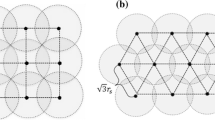Abstract
In this paper, a sensing model for the coverage analysis of wireless sensor networks is provided. Using this model and Monte Carlo method, the ratio of private range to sensing range required to obtain the desired coverage can be derived considering the scale of deployment area and the number of sensor nodes. Base on the coverage analysis, an energy-efficient distributed node scheduling scheme is proposed to prolong the network lifetime while maintaining the desired sensing coverage, which does not need the geographic or neighbor information of nodes. The proposed scheme can also handle uneven distribution, and it is robust against node failures. Theoretical and simulation results demonstrate its efficiency and usefulness.
Similar content being viewed by others
References
Kasbekar G S, Bejerano Y, Sarkar S. Lifetime and coverage guarantees through distributed coordinate-free sensor activation [J]. IEEE/ACM Transactions on Networking, 2011, 19(2): 470–483.
Liu M, Cao J, Lou W et al. Coverage analysis for wireless sensor networks. In: Mobile Ad-hoc and Sensor Networks[M]. Springer, Germany, 2005.
Jain S, Srivastava S. A survey and classification of distributed scheduling algorithms for sensor networks[C]. In: International Conference on Sensor Technologies and Applications. Valencia, Spain, 2007.
Wu K, Gao Y, Li F et al. Lightweight deployment-aware scheduling for wireless sensor networks [J]. Mobile Networks and Applications, 2005, 10(6): 837–852.
Tilak S, Abu-Ghazaleh N B, Heinzelman W. Infrastructure tradeoffs for sensor networks [C]. In: Proceedings of the 1st ACM International Workshop on Wireless Sensor Networks and Applications. Atlanta, USA, 2002.
Cardei M, Du D Z. Improving wireless sensor network lifetime through power aware organization [J]. Wireless Networks, 2005, 11(3): 333–340.
Luo W, Wang J, Guo J et al. Parameterized complexity of max-lifetime target coverage in wireless sensor networks [J]. Theoretical Computer Science, 2014, 518: 32–41.
Zorbas D, Glynos D, Kotzanikolaou P et al. Solving coverage problems in wireless sensor networks using cover sets [J]. Ad Hoc Networks, 2010, 8(4): 400–415.
Mohamadi H, Ismail A S, Salleh S. Solving target coverage problem using cover sets in wireless sensor networks based on learning automata [J]. Wireless Personal Communications, 2014, 75(1): 447–463.
Bulut E, Korpeoglu I. Sleep scheduling with expected common coverage in wireless sensor networks [J]. Wireless Networks, 2011, 17(1): 19–40.
Ma S S, Qian J S. Energy balanced non-uniform distribution node scheduling algorithm for wireless sensor networks [J]. Applied Mathematics & Information Sciences, 2014, 8(4): 1997–2003.
Zhang H H, Hou J C. Maintaining sensing coverage and connectivity in large sensor networks [J]. Ad Hoc & Sensor Wireless Networks, 2005, 1(1/2): 89–124.
Walter J C, Barkema G T. An introduction to Monte Carlo methods [J]. Physica A: Statistical Mechanics and Its Applications, 2015, 418: 78–87.
Cho J, Kim G, Kwon T et al. A distributed node scheduling protocol considering sensing coverage in wireless sensor networks [C]. In: IEEE 66th Vehicular Technology Conference. Baltimore, USA, 2007.
Hill J, Szewczyk R, Woo A et al. System architecture directions for networked sensors [J]. Operating Systems Review, 2000, 34(5): 93–104.
Author information
Authors and Affiliations
Corresponding author
Additional information
Supported by China Scholarship Council(No. 201306255014).
Rights and permissions
About this article
Cite this article
Lü, W., Bai, D. Energy-efficient distributed lifetime optimizing scheme for wireless sensor networks. Trans. Tianjin Univ. 22, 11–18 (2016). https://doi.org/10.1007/s12209-016-2681-3
Accepted:
Published:
Issue Date:
DOI: https://doi.org/10.1007/s12209-016-2681-3




